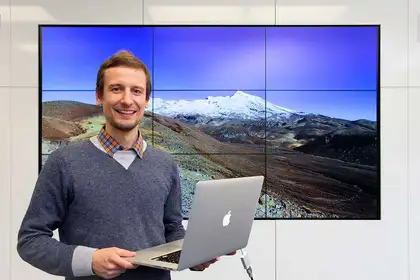
Dr Gabor Kereszturi.
The benefits of hyperspectral and thermal remote sensing technologies for underground research will be discussed at an upcoming workshop at Massey University.
The one-day workshop, Hyperspectral and Thermal Remote Sensing: from data to applications, will feature 18 speakers from the University of Twente in the Netherlands, GNS Science, Manaaki Whenua – Landcare Research, The Xerra Earth Observation Institute, the University of Canterbury, as well as Massey researchers and PhD students. Speakers will be covering remote sensing applications in volcano research, soil and environmental management, geothermal and minerals exploration, and natural hazards assessment.
The gathering has attracted representatives from regional councils, government agencies, universities, crown research institutes and international researchers.
Workshop coordinator Dr Gabor Kereszturi says hyperspectral remote sensing is very new to New Zealand. “This technology has also a lot to offer,” he says. “Remote sensing is a fast and non-invasive approach. It provides a large volume of data with no harm to the environment, making it an excellent new tool to monitor changes of geothermal systems over time. It will also provide much detailed understanding, due to the wealth of data captured by the hundreds of spectral bands, of the geology, hydrogeology, heat and vegetation interactions.
“Hyperspectral sensing forms images of reflected light beyond our eye’s vision at many narrow wavelength channels, informing us about the chemical and physical properties of the Earth's surface. Thermal remote sensing measures, on the other hand, is radiation emitted by the Earth's surface in the form of heat. These two techniques, when combined, can tell us a complex story of hydrothermal alteration, chemical composition of the ground, vegetation structure and its thermal waters, in particular for geothermal areas of New Zealand.”
“The workshop provides a good cross-section of what is going on in New Zealand in this space.”
The Massey team has active projects mapping the mechanical strength of volcanic rocks of Mount Ruapehu using spectroscopy and hyperspectral imaging, funded through the Ministry of Business, Innovation and Employment-funded Natural Hazards Research Platform.
“Massey is one of the leading universities in New Zealand who have the ground and airborne facilities to do research in this rapidly growing research field,” Dr Kereszturi says. “We have been developing new alternative technologies for a low-cost mineral exploration and environmental monitoring with such a versatile technology, while other projects are utilising hyperspectral and thermal remote sensing for a quicker assessment of geothermal site, including the world-famous Wai-o-tapu. At Massey, we have achieved quite a lot, but we still need to catch up with the rest of the world.”
The workshop is part of a joint research project with GNS Science, Enabling hyperspectral and thermal remote sensing to assess renewable geothermal, focused on developing a collaboration with overseas institutions.
Professor Freek van der Meer, Dr Chris Hecker and Dr Harald van der Werff, will attend the Geo-Information Science and Earth Observation, part of the University of Twente, thanks to funding by the Royal Society of New Zealand’s Catalyst Seeding Fund.
“This funding allows us to bring world-leading expertise to New Zealand,” Dr Kereszturi says. “These three have expertise in hyperspectral and thermal remote sensing, satellite technologies and application of remote sensing to geothermal systems. It is important that we foster the relationships with these scientists to help New Zealand gain standing in these areas, and develop new technologies that make a difference in how we manage and monitor these natural resources.”
The team from the Netherlands will stay in New Zealand for a week, joining Massey scientists on a field trip around New Zealand geothermal locations. The tour will include a visit to GNS Science at Wairakei and other geothermal sites around Taupo and Rotorua.